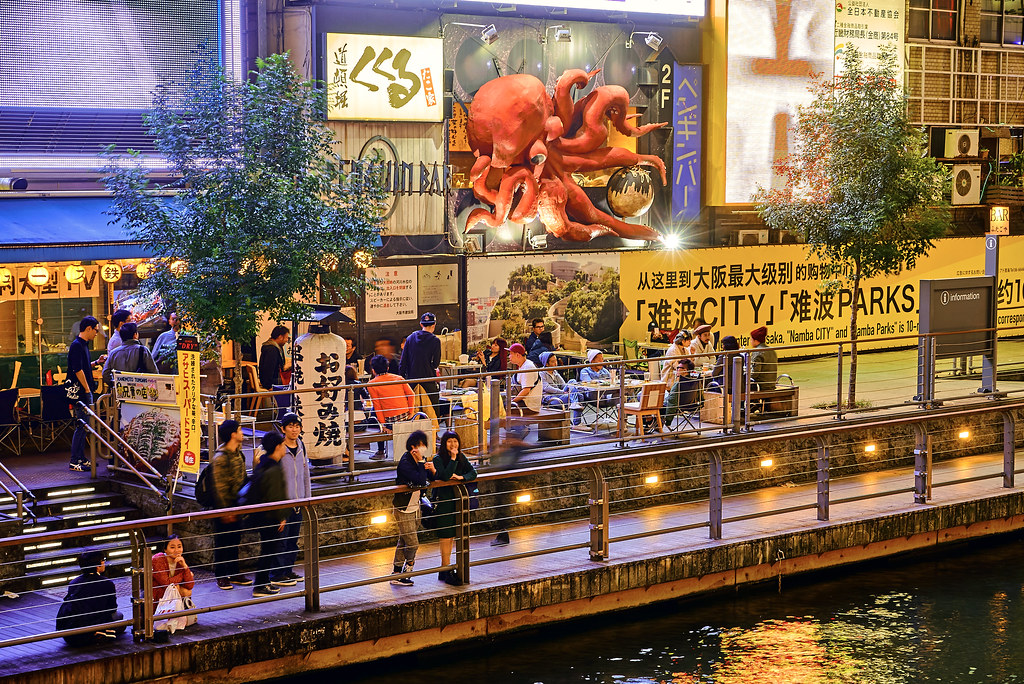Osaka, Japan

Here is a brief history of Osaka:
• Osaka was founded in the 7th century AD as a port town in Japan. It initially developed as a market town along the Naniwa Bay.
• In the 16th century, Osaka grew into a key port city during the Azuchi-Momoyama period under the rule of Oda Nobunaga and Toyotomi Hideyoshi. It became a leading commercial hub for rice trade.
• In the Edo period (1603-1868), Osaka continued to prosper as a major trade port under the Tokugawa shogunate. It developed into a major cultural and economic center of western Japan. Many merchants and traders made fortunes in Osaka during this time.
• In the 19th century, Osaka rapidly industrialized. It became a key center of manufacturing, especially textile mills and shipyards. This led to influx of workers and growth of slums. There were several uprisings by poorer classes in Osaka.
• Osaka was one of the major cities bombed during World War II, especially in 1945. Much of the city was destroyed in the bombings. However, Osaka soon recovered and rebuilt after the war.
• In the post-WWII era, Osaka grew into a major economic powerhouse and became the commercial capital of western Japan. It is a leading port city and has a large shipping industry. Osaka also has many banks, retailers, and manufacturers headquartered there.
• Osaka hosted major events like the Osaka World Exposition in 1970 and the G8 summit in 2000. It has a very vibrant cultural scene with many festivals, food, nightlife, and entertainment options.
• Osaka continues to be an important economic and cultural center of Japan today. It is the second largest city in the country after Tokyo.
Dotonbori: Osaka’s entertainment district with many restaurants, bars, nightclubs and theatres. Cost: Free admission. Hours: 24 hours. Address: 1-8-10 Dotonbori, Chuo-ku, Osaka . Phone: 080-6532-9147.
Osaka Castle: Well-preserved historic castle with stone walls, moats and ramparts. Visitors can climb the castle keep. Cost: 500 yen adult, 300 yen child . Hours: 9am-5pm (Mar-Sep), 9am-4:30pm (Oct-Feb) . Address: 1-1 Osaka-jo, Chuo-ku, Osaka . Phone: 06-4811-4425 . Website: https://www.osakacastlepark.jp/?lang=en
Ningyo Joh: Popular hobby center filled with traditional Japanese dolls, toys, wooden crafts and miniature train sets. Cost: Admission fees apply . Hours: 10am-6pm . Address: 3-7-3 Konohana-ku, Osaka . Phone: 06-6414-9332 . Website: itaminohitsu.co.jp
Umekichi Park: Historic 17–acre park in central Osaka popular for cherry blossom viewing, picnics and the first-of-season Okonomiyaki pancakes. Cost: Free admission . Hours: 5am-8pm (Mar-Sep), 5am-7pm (Oct-Feb) . Address: 2-1-1 Shinsekai, Izumi, Osaka . Phone: 06-4943-0078.
Senko-ji Temple and Nakamozu Shrine: Historic temples dedicated to Inari, the fox spirit and guardian of fox familiars. Surrounded by large park. Cost: Free admission . Hours: 8:30am-4pm . Address: 2-5-1 Nakamozu, Osaka . Phone: 06-6381-6281 . Website: http://senkoji.or.jp/
The currency code for Japanese Yen is JPY. The currency of Japan is the Japanese Yen (JPY). Some key denominations of Japanese Yen are:
Banknotes:
•1 Yen = 1 JPY
•5 Yen = 5 JPY
•10 Yen = 10 JPY
•50 Yen = 50 JPY
•100 Yen = 100 JPY
•500 Yen = 500 JPY
•1000 Yen = 1000 JPY
•5000 Yen = 5000 JPY
•10,000 Yen = 10,000 JPY
Other larger denominations also exist like 20,000 JPY and 50,000 JPY coins and notes. The Japanese Yen is subdivided into 100 sen. So for example, 315 Yen would be written as 3((15)) in Japanese. The Bank of Japan is responsible for issuing the Japanese Yen.
Coins: come in denominations of 1, 5, 10, 50, 100, 500 and 1000 Yen. Banknotes come in denominations of 10,000, 20,000, 50,000 and 100,000 Yen.
Osaka has a humid subtropical climate with hot summers and mild winters. Some key facts about Osaka’s climate:
• The humidity is high year-round, reaching 80-90% in the summer. Average high temperatures in August, the warmest month, are around 88 F or 31 C.
• Winters in Osaka are mild with average high temperatures of only around 46 F or 8 C in January. Occasionally, temperatures can drop below freezing.
• Osaka gets moderate rainfall, with the most rain falling in summer. Average annual rainfall is around 60 inches or 1525 mm.
• Typhoons can affect Osaka during the summer and early fall. These tropical storms can bring strong winds and heavy rain.
• Snowfall is rare in Osaka, occurring only a few times per year typically in January or February. The snow does not often accumulate.
Here are the major airports near Osaka:
Itami Airport (IXW): train: 40 min by Osaka Itami Airport Rapid Line, 15 km from Osaka center. Fare: 480 yen. Website: https://www.osaka-airport.co.jp/
Metro: Connected to the Osaka Monorail. 15 min ride to and from Osaka center. Fare: 210 yen.
Kansai International Airport (KIX): train: 53–64 min by Haruka Limited Express, 190 km from Osaka center. Fare: 5640 yen. Website: https://www.kansai-airport.or.jp/en/
Metro: Ride the Nankai Main Line to Namba, transfer to Osaka subway. Total travel time 90 min. Fare: 1400 yen. Shuttle: 60 min by shared shuttle bus. Departure from Osaka hotels. Fare: 6000 yen. Website: https://www.kansai-airport.or.jp/en/access/t2
Bus: Bus | Kansai International Airport (kansai-airport.or.jp)
Car share: 60–90 min depending on traffic. Osaka city center to KIX: 70km. Estimate 5500 yen in tolls and gas. Download Uber from app store or use a taxi.
Taxi: 70-90 min depending on traffic. Osaka city center to KIX: 70km. Fare: Approximately 20000 yen. Taxi stands are at the airport.
Other options: Private charter buses and trains also available for larger groups.
Here are the major types of transportation in Osaka:
•Subway (Osaka Metro): Fares range from 150 yen to 600 yen depending on the distance traveled. Osaka has an extensive subway system covering most of the city. Website: https://www.osaka-metro.co.jp/cost.html
• Commuter rail (JR West): Fares range from 220 yen to 5000 yen for trips within Osaka city. JR trains connect Osaka station to major hubs like Kyoto and Kobe. https://www.westjr.co.jp/
•Bus: Fares range from 190 yen to 890 yen depending on the route. Osaka city buses cover residential areas not serviced by the subway. Website: https://bus.osakametro.co.jp/en/
•Taxi: Approximately 800-1000 yen for the first 2 km, then 200 yen per additional 250 meters. T street or booked in advance.
•Car rental: Daily rates range from around 3,000 to 15,000 yen per day for a compact to full-size rental car depending on the agency. Several major rental car companies operate in Osaka including Hertz, Avis, Nissan Rent-a-Car, etc.
•Bicycle sharing: Osaka Bike Share offers bikes for rent starting at 100 yen for the first 30 minutes. Monthly membership fees start at 1500 yen. Website: https://www.osakabikeshare.jp/english/
Popular Day Trips From Osaka:
**Nara Park** Filled with over 1,000 freely roaming deer and historic temples like Tō-jō-dō. Approximately 30 km from Osaka. Price: $3 admission. Address: Nara-shi, Nara-ken, Japan : 0742-22-5511 https://www.city.nara.lg.jp/site/kanko/nara.htm
**Arashiyama Bamboo Forest** Magical forest filled with swaying bamboo stalks. Distance from Osaka: 16 km. Free admission. Address: Arashiyama, Nishikyō-ku, Kyōto-shi, Kyōto, Japan : 075-863-3156. https://www.jrailpass.com/blog/arashiyama-bamboo-forest
**Himeji Castle** Well preserved historic castle with stunning stone ramparts. 1.5 hours: 42 km from Osaka . $10 admission : 68 Konpira-cho, Himeji, Japan. Phone: 079-285-0001. Website: https://www.himejicastle.jp/
Port and Kitano Treetown** Wander the port frequented by imported goods and unique neighborhood with tree-lined cobblestone streets. Approximately 21 km from Osaka. Free to explore. Address: Kobe, Japan.
**Shukkeien Garden** Tranquil Japanese stroll garden with bamboo, ponds and mountains. Approximately 54 km from Osaka. Price: $10 admission. Address: Shukkeien, Himeji, Japan. Phone: 079-222-6565. Website: https://www.shukkeien.jp/




